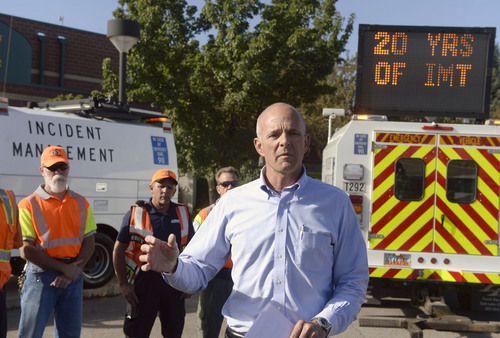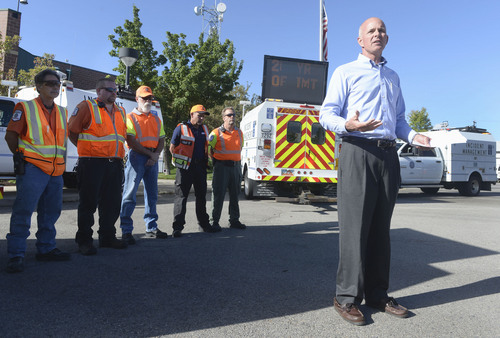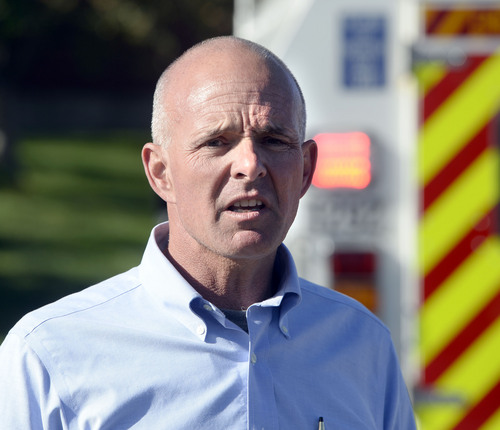This is an archived article that was published on sltrib.com in 2014, and information in the article may be outdated. It is provided only for personal research purposes and may not be reprinted.
Jeff Reynolds says his favorite memory as an Incident Management Team driver for Utah's transportation department was a snowy day when he patrolled Interstate 80 to look for anyone who needed help. He saw some tracks in the snow that led off the freeway and over a hill.
He stopped, saw a car far down the hillside and thought maybe it had been abandoned after a crash. "I walked down and knocked on the window," he said. "The elderly couple inside started yelling for help."
"The lady was having a hard time breathing because she was upside down with the seat belt and had restricted breathing," Reynolds adds. He and a highway patrolman cut her out.
"Who knows how long they would have been there otherwise? That's one of the reasons people call us their guardian angels."
Incident Management Teams, operated by the Utah Department of Transportation, celebrated their 20th anniversary on Monday — and UDOT used the ceremonies to urge safe driving as fall begins and wintry weather lurks.
The white trucks with flashers and electronic signs have assisted 123,000 drivers — roughly the population of West Jordan — in the 10 years they have been keeping detailed records. Besides responding to crashes, they change tires, provide fuel for drivers who run out of gas, remove debris from roads and handle many other problems, from hazardous-waste spills to offering first aid.
The state has 15 such teams — seven in Salt Lake County, with the rest scattered on urban freeways along the Wasatch Front and in Washington County.
"We save the lives of first responders and the public," Reynolds said. "No Highway Patrol trooper has been hit in the past 10 years when one of us has been behind them at a crash. So they like to see us."
The teams patrol freeways from 6:30 a.m. to 7 p.m. seven days a week, and are on call at other hours. They are often dispatched to trouble spots by UDOT crews watching freeway cameras, or by the Highway Patrol — and they also patrol themselves to seek people who need help.
In the past 10 years, they have responded to 36,840 incidents, removed debris from the roadway 26,768 times and dispensed 8,431 gallons of gasoline.
"We figure it's safer for us to give someone a gallon of gasoline when they run out than to have them try to walk along the freeway" with high-speed traffic zipping around them, Reynolds said.
In fact, UDOT Executive Director Carlos Braceras on Monday urged people to never leave their cars on freeways, and to phone for help from the teams or the Highway Patrol.
"If you are on the freeway, please don't stop unless it's a true emergency. And if you are in a situation where you have to stop, pull off to the side as far as you can and do not get out of your vehicle," he said.
"Call for assistance. Even if you don't have a phone, our freeway cameras are watching the freeways at all times," he said, adding that help will be dispatched in urban areas.
Braceras reminds drivers that when they see emergency vehicles on the side of the freeway — including incident management teams — state law requires them, if possible, to pull out of the lane next to the vehicle to give extra space, and to slow to a safe speed.
Workers have too many close calls, Reynolds said. He remembers one day he had just set up orange cones around an accident and was walking back to his truck. A car going too fast hit all the cones, but swerved to barely miss him.
"I didn't actually see it," he said. "Other guys called me to say that was a close one."
As wintry weather is around the corner, Reynolds urges people to ensure they have working spare tires. "We can't do much to help them if they don't."
"Make sure you have enough fuel as you begin your trip," Braceras adds. "Stay buckled up. Make sure your tires are properly inflated. Improper inflation is a reason behind some crashes."
Braceras said, "As we enter into the winter months, give yourself more following distance. Do not ride right on the tail of cars you are following. Give yourself more time to react."
Besides helping safety, Braceras said the Incident Management Teams have helped reduce congestion. "Every minute we can clear an accident faster results in a savings of five minutes of congestion."











